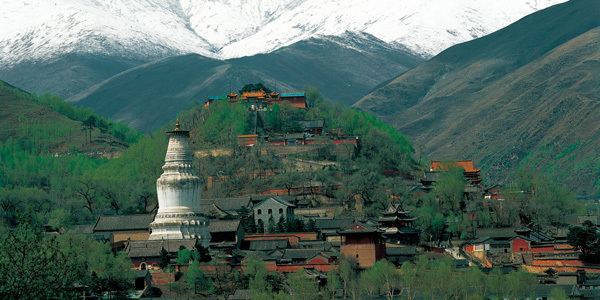Easiest route Hike Prominence 1,781 m | Elevation 3,058 m | |
 | ||
Similar Mount Putuo, Mount Emei, Mount Jiuhua, Mount Heng, Mount Hua | ||
Mount Wutai (Chinese: 五台山; pinyin: Wǔtái shān; literally: "Five Plateau Mountain"), also known as Wutai Mountain or Qingliang Shan, is a Buddhist sacred site located at the headwaters of river Qingshui, in the Chinese northeastern province of Shanxi, surrounded by a cluster of flat-topped peaks (North, South, East, West, and Central). The North peak, called Beitai Ding or Yedou Feng, is the highest (3,061 m) of these, and is also the highest point in northern China.
Contents
Map of Wutai Shan, Fanshi, Xinzhou, China
As host to over 53 sacred monasteries, Mount Wutai is home to many of China's most important monasteries and temples. It was inscribed as a UNESCO World Heritage Site in 2009.
Introduction
Mount Wǔtái is one of the Four Sacred Mountains in Chinese Buddhism. Each of the four mountains are viewed as the bodhimaṇḍa (dàocháng; 道場) of one of the four great bodhisattvas. Wǔtái is the home of the Bodhisattva of wisdom, Mañjuśrī or Wénshū (文殊) in Chinese. Mañjuśrī has been associated with Mount Wutai since ancient times. Paul Williams writes:
Apparently the association of Mañjuśrī with Wutai (Wu-t'ai) Shan in north China was known in classical times in India itself, identified by Chinese scholars with the mountain in the 'north-east' (when seen from India or Central Asia) referred to as the abode of Mañjuśrī in the Avataṃsaka Sūtra. There are said to have been pilgrimages from India and other Asian countries to Wutai Shan by the seventh century.
Wutai was the first of the four mountains to be identified and is often referred to as "first among the four great mountains". It was identified on the basis of a passage in the Avataṃsaka Sūtra, which describes the abodes of many bodhisattvas. In this chapter, Mañjuśrī is said to reside on a "clear cold mountain" in the northeast. This served as charter for the mountain's identity and its alternate name "Clear Cool Mountain" (Ch: Qīngliáng Shān; 清涼山).
The bodhisattva is believed to frequently appear on the mountain, taking the form of ordinary pilgrims, monks, or most often unusual five-colored clouds. Mount Wutai also has an enduring relationship with Tibetan Buddhism.
Mount Wutai is home to some of the oldest existent wooden buildings in China that have survived since the era of the Tang Dynasty (618–907). This includes the main hall of Nanchan Temple and the East Hall of Foguang Temple, built in 782 and 857, respectively. They were discovered in 1937 and 1938 by a team of architectural historians including the prominent early 20th century historian Liang Sicheng. The architectural designs of these buildings have since been studied by leading sinologists and experts in traditional Chinese architecture, such as Nancy Steinhardt. Steinhardt classified these buildings according to the hall types featured in the Yingzao Fashi Chinese building manual written in the 12th century.
In 2008, there were complaints from local residents that in preparation for Mount Wutai's bid to become a UNESCO World Heritage Site, they were forced from their homes and relocated away from their livelihoods.
Major temples
Nanshan Temple (Chinese: 南山寺) 38.9815°N 113.5738°E / 38.9815; 113.5738 is a large temple in Mount Wǔtái, first built in the Yuan Dynasty. The whole temple comprises seven terraces, divided into three parts. The lower three terraces are named Jile Temple 極樂寺); the middle terrace is called Shande Hall (善德堂); the upper three terraces are named Youguo Temple (佑國寺). Other major temples include Xiantong Temple, Tayuan Temple and Pusading Temple.
Other important temples inside Mount Wutai include: Shouning Temple, Bishan Temple, Puhua Temple, Dailuo Ding, Qixian Temple, Shifang Tang, Shuxiang Temple, Guangzong Temple, Youguo Temple, Guanyin Dong, Longhua Temple, Luomuhou Temple, Jinge Temple, Zhanshan Temple, Wanfo Ge, Guanhai Temple, Zhulin Temple, Jifu Temple, Gufo Temple, etc.
Outer Mount Wutai temples include: Yanqing Temple, Nanchan Temple, Mimi Temple, Foguang Temple, Yanshan Temple, Zunsheng Temple, Guangji Temple, etc. A giant statue of Maha Manjushree was presented to the Buddhists of China by foreign minister of Nepal Ramesh Nath Pandey in 2005.
Transportation
The Wutaishan Airport in nearby Dingxiang County, opened in December 2015.
